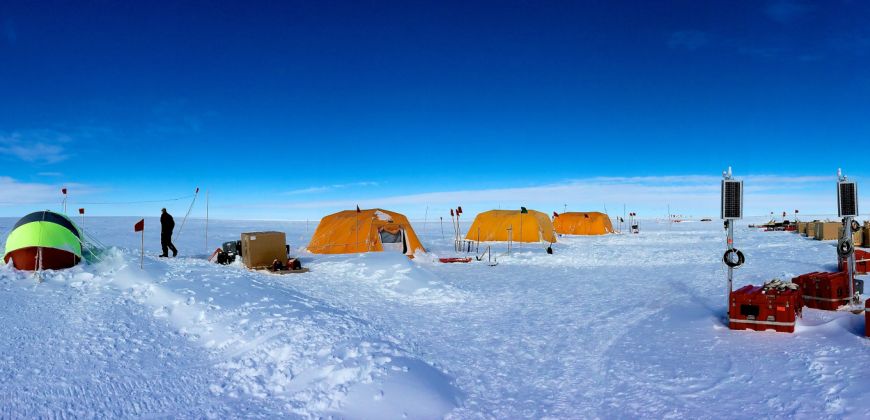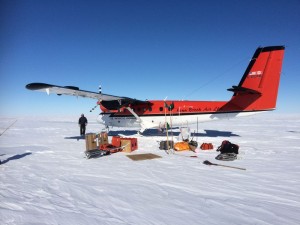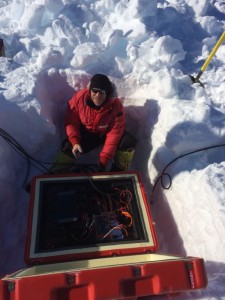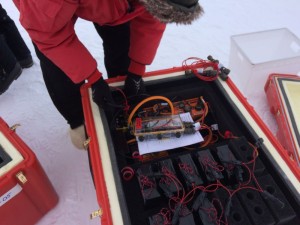
Thanks to new technology, researchers will have the first glimpse of the earth below the Ross Ice Shelf in Antarctica, filling a gap in our understanding of the Antarctic continent that lies beneath a 1000-foot thick expanse of floating ice the size of Texas.
Research in Antarctica is novel to Colorado State University Geosciences Ph.D. student Rob Anthony in a number of ways.
‘Wild and untouched’

“The coolest part about doing research in Antarctica is it’s so wild and untouched,” said Anthony. “You are literally putting your feet where no human has stepped before.”
When your foot comes down on untrammeled ice the visual impact is immediate.
“When you step on the ice you can sometimes create a hoar’o’quake, and can watch the ice ripple away from your foot in all directions,” Anthony explained. “The first time it happened I thought I was about to fall into a crevice.”
Below the ice shelf
Anthony is part of a three-year National Science Foundation study aimed at understanding the structure of the earth below the ice shelf and the rates of change in the shelf itself as it is jostled by waves and flows into the Antarctic ocean at rates of up to over half a mile per year. Aside from the intricacies of doing research in Antarctica the ice shelf presents unique challenges for geologists.

“Normally a geologist can put their hammer to the rocks they are studying and get samples but in this case you’ve got ice and then water between you and the study area,” said Anthony.
The project, a partnership between CSU’s Warner College of Natural Resources, the Scripps Institution of Oceanography, Woods Hole Oceanographic Institution, Washington University, and Pennsylvania State University, aims to leverage new technological developments in seismic instrumentation to advance our basic knowledge of the “last continent” and its buried mountain ranges, volcanoes, and vast glaciers. These developments include new extreme lithium-ion battery technologies to power an array of seismomographs buried in the ice shelf. These compact, light, and reliable systems are now suitably small that multiple stations can be carried, along with a science crew, in a small (Twin Otter) aircraft.
Largest of its kind
This new array, the largest of its kind ever deployed across an ice shelf, will work off solar panels in the sunny months – roughly 7 months of the year – and the smaller, lighter, lithium ion batteries in the winter. The array is collecting data on subtle movements in the earth generated by the ocean and by earthquakes and will be utilized to give the team a seismic cat scan of the structure of the deep earth below the ice extending to depths of hundreds of miles.

These images will assist with an understanding of the rift system below the Antarctic continent, how the Transantarctic Mountains formed, and what the source of heat is for volcanoes such as Mt. Erebus, the earth’s southernmost volcano.
The array will also detect ocean waves interactions with the ice shelf and changes in the ice itself giving researchers a measure of the strength and integrity of the shelf. A collapse of the Ross Ice Shelf and similar structures in the polar regions has the potential to cause significant changes in sea level as land-based glaciers further inland accelerate into the ocean and melt.
Fire and ice
The combination of deep magmatic fire and ice is as unique as Antarctica’s landscape itself, and for researchers like Anthony that’s all part of the appeal.
“When I’m sitting in a twin-prop sea otter and the blades start to spin I always get the Indiana Jones music running through my head,” said Anthony.
That spirit of adventure is only beginning as the team will return over the next few years to maintain the network and to retrieve and analyze data that will no doubt bring interesting new discoveries in an area where our current understanding of our planet is so limited.